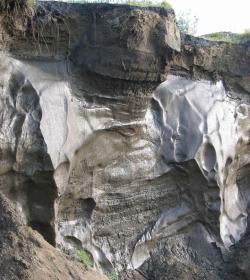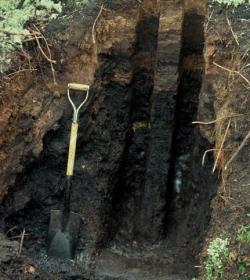Science Highlight
Expert assessment of vulnerability of permafrost carbon
to climate change
Schuur EAG, Abbott BW, Bowden WB, Brovkin V, Camill V, Canadell JG, Chanton JP, Chapin III FS, Christensen TR, Ciais P, Crosby BT, Czimczik CI, Grosse G, Harden J, Hayes DJ, Hugelius G, Jastrow JD, Jones JB, Kleinen T, Koven CD, Krinner G, Kuhry P, Lawrence DM, McGuire AD, Natali SM, O'Donnell JA, Ping CL, Riley WJ, Rinke A, Romanovsky VE, Sannel ABK, Schädel C, Schaefer K, Sky J, Subin ZM, Tarnocai C, Turetsky MR, Waldrop MP, Walter Anthony KM, Wickland KP, Wilson CJ, Zimov SA.
Climatic Change (2013) 119:359–374
DOI 10.1007/s10584-013-0730-7
Lead
The overall amount, rate, and form of C released to the atmosphere in a warmer world will influence the strength of the permafrost C feedback to climate change. We used a survey to quantify variability in the perception of the vulnerability of permafrost C to climate change. Experts were asked to provide quantitative estimates of permafrost change in response to four scenarios of warming.
Paper Abstract
Approximately 1700 Pg of soil carbon (C) are stored in the northern circumpolar permafrost zone, more than twice as much C than in the atmosphere. The overall amount, rate, and form of C released to the atmosphere in a warmer world will influence the strength of the permafrost C feedback to climate change. We used a survey to quantify variability in the perception of the vulnerability of permafrost C to climate change. Experts were asked to provide quantitative estimates of permafrost change in response to four scenarios of warming.
For the highest warming scenario (RCP 8.5), experts hypothesized that C release from permafrost zone
soils could be 19–45 Pg C by 2040, 162–288 Pg C by 2100, and 381–616 Pg C by 2300 in CO2 equivalent using 100-year CH4 global warming potential (GWP). These values become 50 % larger using 20-year CH4 GWP, with a third to a half of expected climate forcing coming from CH4 even though CH4 was only 2.3 % of the expected C release. Experts projected that two thirds of this release could be avoided under the lowest warming scenario (RCP 2.6).
These results highlight the potential risk from permafrost thaw and serve to frame a hypothesis about the magnitude of this feedback to climate change. However, the level of emissions proposed here are unlikely to overshadow the impact of fossil fuel burning, which will continue to be the main source of C emissions and climate forcing.
Manuscript
- Download paper: http://link.springer.com/article/10.1007%2Fs10584-013-0730-7#page-1
- Contact lead author: E. A. G. Schuur
Illustrative Photos (available free if credited as specified). |
||
|---|---|---|
 |
 |
|
Frozen soil sediment deposit in Siberia. |
Frozen peatland soil from the Hudson Bay Lowlands, Canada. |
|
